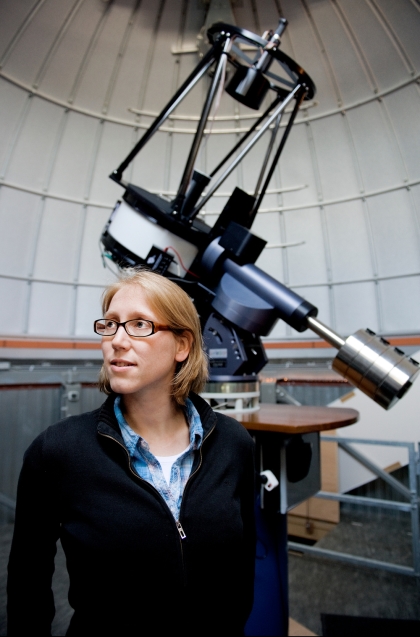Press Release 14/2013 - September 4, 2013
Pinpointing the ages of stars
Astronomer Saskia Hekker from the Max Planck Institute for Solar System Research receives ERC Starting Grant.
Dr. Saskia Hekker from the Max Planck Institute for Solar System Research (MPS) in Germany has been awarded a prestigious Starting Grant from the European Research Council (ERC). With these Starting Grants the ERC provides young talented scientists with the opportunity to start their own research groups. In the next five years, Hekker will receive 1.5 million Euros to determine the ages of stars through asteroseismology.
Within its lifetime a star undergoes dramatic changes: A newly born protostar first develops into a hydrogen-burning main-sequence star (such as the Sun) that may be stable for several billions of years. When its fuel becomes exhausted, a Sun-like star first expands to form a red giant and finally collapses into a white dwarf. Although the basic stages of this evolution are well-known, not all details are understood. "Since stars exist for billions of years, it is impossible to study processes in real time", says Hekker. Instead, to obtain a full picture of stellar evolution it is necessary to observe many stars in different evolutionary stages. "Accurate ages are then essential to correlate the results of the different stars meaningfully in terms of stellar evolution", Hekker explains.

|
Abbildung 1: Dr. Saskia Hekker from the Max Planck Institute for Solar System Research in Germany has been awarded a prestigious Starting Grant from the European Research Council.
|
(Credits: Jan-Willem Steenmeijer
|
However, ages of stars are difficult to determine as there is no direct observable that is sensitive to age and age only. Instead, stellar ages have to be derived from a combination of observables such as temperature, luminosity and other surface properties. Asteroseismology - the study of the internal structure of stars through their global oscillations - makes it possible to determine stellar ages with high accuracy by probing the central regions of stars, where nuclear reactions take place. "this way, we can study directly the processes most sensitive to stellar age", Hekker adds.
From 1 October 2013, Dr. Saskia Hekker will start her ERC-project at the MPS in the new department "Solar and Stellar Interiors" lead by Prof. Dr. Laurent Gizon. After having received her PhD from the Leiden University in the Netherlands in 2007, Hekker worked at the Royal Observatory of Belgium and the University of Birmingham. In 2011 she was awarded a prestigious Veni Fellowship from the Netherlands Organisation for Scientific Research to continue her research at the Astronomical Institute 'Anton Pannenkoek', University of Amsterdam.
The MPS is currently relocating from Katlenburg-Lindau to a new building near the North Campus of the Georg-August-Universität Göttingen. The new building will host scientists and high-tech facilities to build and test instruments for space missions, such as ESA's upcoming cometary mission Rosetta and ESA's solar mission Solar Orbiter.
Contact
Dr. Birgit Krummheuer
Press and Public Relations
Max Planck Institute for Solar System Research
Max-Planck-Straße 2
37191 Katlenburg-Lindau
Tel.: 05556 979 462
Fax: 05556 979 240
Mobil: 0173 3958625
Email: krummheuer mps.mpg.de
mps.mpg.de
Prof. Dr. Laurent Gizon
Max Planck Institute for Solar System Research
Max-Planck-Straße 2
37191 Katlenburg-Lindau
Tel.: 05556 979-439
Email: gizon mps.mpg.de
mps.mpg.de
Dr. Saskia Hekker
Max Planck Institute for Solar System Research
Max-Planck-Straße 2
37191 Katlenburg-Lindau
Tel.: 05556 979-124
Email: hekker mps.mpg.de
mps.mpg.de
